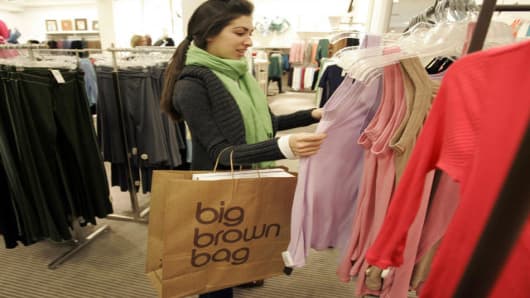"Granted, the bulk of holiday hiring is usually recorded in November, but the October figure often provides a good clue of how retailers perceive hiring needs for the season," said Chief Executive John Challenger. "If previous years are any indication, we could still see 300,000 to 350,000 new retail jobs added in November. Anything less than 300,000 new jobs would be a sure sign that retailers consider this year an absolute bust – hiring extra workers would not only strip away meager profits, but it would be unnecessary based on low customer traffic."
Lowered Earnings Forecasts
Even worse, department stores Macy’s, J.C. Penney, and Kohl’s and specialty retailer Williams-Sonomaall have lowered their earnings forecasts in recent days.
These downward revisions, which follow on the heels of two-straight months of weak monthly chain-store sales results, have certainly stoked the concerns about this holiday season.
"It is always a little bit dangerous to focus on one retailer or even one sector," said Julia Coronado, senior U.S. economist at Barclays Capital. She recalled that last year investors feared weak department store sales would translate into soft holiday sales, only to discover that consumers bought record numbers of flat-screen televisions.
The trends also may not be all that surprising given the climate we are in right now. Several industry analysts said they expect mid-tier department stores will continue to see the weak sales because whenever middle-income consumers are feeling pinched, they are likely to trade down to discount retailers such as Wal-Mart. Meanwhile, affluent consumers are less likely to fell the current pressures and will likely continue to shop at high-end stores such as Nordstrom and Saks.
One sign that this may indeed be playing out is that Wal-Mart continues to forecast a strong holiday season.
Wal-Mart may be playing its cards just right for this year’s holiday shopper. The world’s largest retailer began its price discounts early and is offering consumer-friendly services such as the ability to order products online and pick them up at the store without shipping and handling charges.
"What it did was send a message that Wal-Mart’s value proposition is about low prices," said Bill Marquard, a former consultant to Wal-Mart who recently published a book called "Wal-Smart: What It Really Takes to Profit in a Wal-Mart World." He expects these strategies will help improve traffic at Wal-Mart.
"I really see Target and Wal-Mart being the big winners this year," he said.
Christina Cheddar Berk is a News Editor at CNBC.com. She can be reached at christina.cheddar-berk@nbcuni.com.




